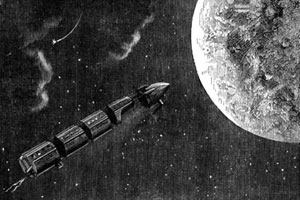 Artwork from Jules Verne’s 1865 novel, From the Earth to the MoonLaunching a spacecraft bound for the Moon with the deliberate intention of striking the Moon in a spectacular impact!
Artwork from Jules Verne’s 1865 novel, From the Earth to the MoonLaunching a spacecraft bound for the Moon with the deliberate intention of striking the Moon in a spectacular impact!
Sounds like something out of a Jules Verne novel... but that's exactly what NASA's up to this year with the upcoming LCROSS (Lunar Crater Observation and Sensing Satellite) mission, scheduled for launch on June 2nd and impact sometime in October-- exact date TBA.
And it's not unprecedented, either: the Lunar Prospector spacecraft back in 1998/1999, whose instruments detected possible signs of water ice in craters around the Moon's poles, was crashed into the Moon's South Pole at the end of its mission. The aim was to blast up a cloud of material from the lunar surface and spectroscopically analyze the plume in search of water vapor. None was detected then, but that's where LCROSS comes in.
LCROSS will seek to verify the presence or absence of water ice and related hydrated materials buried at the bottom of a permanently shadowed crater floor on the Moon's South Pole. Water ice cannot persist on any part of the Moon's surface that is subjected to sunlight, but because of the Moon's low axial tilt with respect to the ecliptic (the Sun's apparent annual path in the sky)-- only about 1.5 degrees-- there are craters at the Moon's poles whose floors never see the light of day, all month long and year round. Water ice could persist near the surface in these places.
LCROSS consists of two pieces: a "Shepherding Spacecraft" that will guide the whole affair to the proper location on the Moon's South Pole, and the Centaur rocket stage that propelled the spacecraft to the Moon. The pair will separate, and the Centaur rocket will become the primary impactor, striking ground and producing a crater and plume of ejected material. Viewing the event from above, the Shepherding Spacecraft will use cameras and other instruments to analyze the plume from a distance, and will then follow the same course as the Centaur, descending four minutes after impact through the ejected plume and analyzing material samples as it falls.
